Uniform and Equipment of 1914
Note: All images used without permission. Original sources are cited at bottom of page.
Soldier's Kit Officer's Kit:
August 1914 August-December 1914
September-December 1914

The Defining Features: red trousers, dark blue double-breasted greatcoat, red kepi (with dark blue cover), black leather accoutrements.
The year of naivety, sacrificial zeal and blind obedience. Hundreds of thousands of men sacrifice themselves with "Pour la France!" on their lips. An antiquated mentality carried over from the previous century transfixed the minds of the French military leaders. The "doctrine of the offensive" held the belief that through sheer élan (the spirit of the highly-motivated individual soldier) any obstacle could be overcome - man or material. By this thinking, the bayonet could defeat the machine-gun when wielded in the hands of the charging soldier; a rushing, determined infantry charge could overcome even the most deeply entrenched enemy. To stop the advance of the German army, French soldiers were hurled across open fields toward the enemy. Waves of advancing infantry were simply mowed down by storms of bullets and shrapnel fire.
The uniform of the pioupiou ("young soldier") as the French soldier of '14 was called, reflects the mentality of 'attaque à outrance' ("all-out attack"). Bold and brilliant in color, it is another relic suited more for the battlefields of the 19th century and the age before smokeless powder. The men wore as their primary garment a greatcoat made of iron blue wool, officially called "gris de fer bleuté" ("bluish iron gray"). It was constituted of 90% indigo-dyed and 10% raw (undyed) wool. The trousers of the men were made of garance, or "madder" wool: a striking red that was intended to instill a sense of boldness in the soldier. Ironically enough, the original natural madder culture had been abandoned in France in the late 19th century, and it was necessary to turn to Germany for a chemical dye (alarizine) which replicated the color. The primary headgear of the French soldier, the képi, was also made from madder wool (although covers were made for these in a modest concession to reducing the soldier's visibility). The rank and regimental insignia on the greatcoat also utilized the madder wool. The highly conspicuous uniform would doubtlessly contribute to the staggering losses suffered by the French army in 1914.
Even before the war had begun, it was conceded that dramatic measures had to be taken to reduce the visibility of the men's uniforms. Though four previous attempts had already been made in the pre-war years, all had failed. In July 1914, it was finally decided to use the cloth termed "tricolor" (composed of 60% blue, 30% red and 10% white wool). But when it was discovered that the red used in its construction was produced by the German chemical dye alarizine, it was decided to proceed without this component. The resulting shade was officially called bleu clair ("light blue"). The first runs utilized dyes that proved unstable, fading into a light bluish-gray after continued exposure to the elements. Once the dye was better regulated in 1915, a more uniform shade was reached and it was this cloth that would be called bleu horizon ("horizon blue"). Yet French stocks alone could not support the needs of the army, and calls were made to Spain, the U.S. and especially Britain to supply additional cloth that was similar in nuance. These ranged from violet blue to gray, and all shades in between. Despite the different countries of origin, all imported cloth was universally referred to as gris bleuté d'Angleterre ("English bluish-gray") -- though true British wool was normally a dark blue-gray. While the new uniform gradually began distribution, temporary measures would be taken to help reduce the visibility of the old uniform.
Soldier's Kit: August 1914
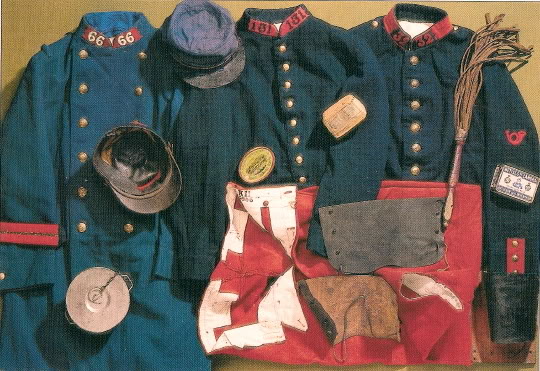
French infantryman uniform, Aug. 1914. From the left to right: greatcoat m. 1877, kepi m. 1884 with cover, jacket m. 1870, tunic m. 1897, trousers m. 1867/93, gaiters m. 1913.
Uniform:
le Képi ("kepi"): model 1884, wool; dark blue band, madder turban and cap, black leather visor, dark blue piping. Two aeration vents are fitted on either side of the cap. The regimental patch (the digits in madder) is sewn onto a rectangular dark blue patch which itself is sewn onto the front of the cap. The interior lining is of coated linen with a rough black leather sweat band. Many men would retain their original red kepis into the spring and summer of 1915.
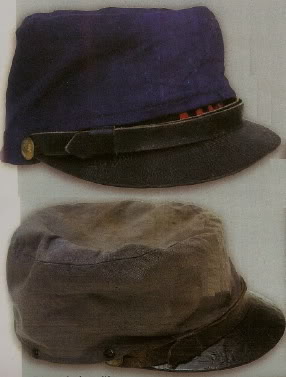
Kepi m. 1884 with kepi cover m. 1913 (top) and a kepi with a private purchase kepi cover showing signs of fading from exposure to the elements.
le Couvre-Képi ("kepi-cover"): model 1912, iron blue (dyed) cotton; the cover was secured to the kepi using a cinching cord and two button holes on either side. There were also three rear loops on the cover that were intended to receive the hooks of the detachable neck-cover (rarely seen in 1914). It was this model that was most common in August 1914.
Model 1913, impermeable cotton, manufactured in dark blue cloth; the three loops on the rear of the cover are replaced by three blackened iron buttons, and the three hooks on the neck-cover are replaced with three button holes.
Simplified model (1914), impermeable cotton, manufactured in iron blue cloth. As a exigent measure, the simplified model is produced (beginning in August 1914) only in the cap component (i.e. with no neck-cover nor means of attaching one). In principal, this model was intended for distribution among the reserve and territorial units.
A feature shared by every model of kepi-cover was the rapidity at which they became discolored after continual exposure to the elements. Under the August sun, they first faded to an ash blue. Through the months, the look of the covers will be for the less disparate, turning every possible shade of blue: faded out, whitened by dust, stained by mud, greened by moisture. Additionally, private purchase kepi-covers in a similar shade to the regulation issue or in oiled canvas were also procured.
la Capote ("greatcoat"): model 1877, iron blue wool ("technically, bluish iron-gray -- 90% indigo-dyed, 10% unbleached white); double-breasted with two rows of six buttons (model 1871) in brass with flaming grenade in relief; button-back capes; standing collar; linen lining. The collar patches consist of the regimental numerals in iron blue, sewn onto a madder patch. The shoulder strap is either the model 1908 (consisting of a single roll) or the model 1913 (a stacked double roll). It was a common practice to wear only the right shoulder strap, or to wear neither. A belt loop is located on the left side of the greatcoat, which fastens via a small button. The cuff facings are closed by way of a small button as well. It is the model 1877 greatcoat that by far will be the most common in 1914. Although it will be completely replaced by the spring of 1915, the model 1877 greatcoat will continue to be worn up to the end of the war by new recruits during their training period, often receiving their horizon-blue uniforms just before departing to the front.
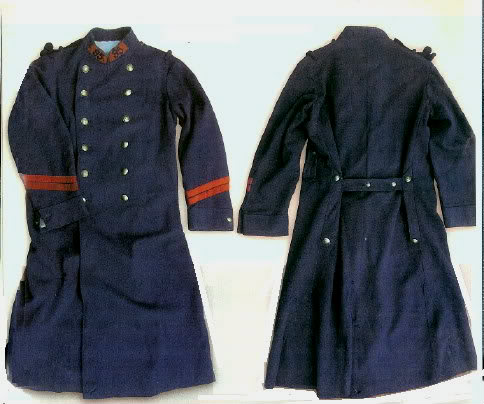
Greatcoat model 1877.

A rare example of a m. 1877 greatcoat which has a fall-down collar in place of the regulation stand-up one. Contrary to regulations, the regimental numbers have been sewn directly onto the collar.
Model 1877/14, light blue wool; double-breasted with two rows of six buttons. The buttons, collar patches, martingale, belt loop, shoulder straps and shoulder loops are the same as those on the model 1877. Made with both a standing collar and a large half-chevallière, or fall-down, collar. The modified '14 no longer has facings or buttons on the cuffs. As the first stocks of new light blue cloth arrived in August, certain manufacturers produce items that, in the absence of official directives from the War Ministry, integrally preserve the pre-war uniform cut. It isn't until the end of September that the description of the new uniform (model 1914) is sent out. It was in this short lapse of time that a significant amount of the model 1877/14 greatcoats were produced using the new wool. However, once the army had released the description of the much more simplified model 1914, it became immediately clear that it would be less costly and time-consuming to produce. Thus, after only a month of production, manufacturers quickly switched to making the regulation model.

Greatcoat m. 1877/14.

Three men in this photo, including the NCO, are fitted out in m. 1877/14 greatcoats (double-breasted). The others wear the m. 1914. Fall of 1914.
la Veste ("jacket"): model 1870, dark blue wool (100% indigo-dyed) of a finer cloth than that used in the greatcoat; single-breasted with one row of nine small buttons (model 1871) in brass with flaming grenade in relief; white canvas lining. Commonly referred to by the soldiers as the ras-de-cul or simply ras-cul ("bare-ass") due to its short length, the jacket was only to be worn at barracks or bivouacs at off-duty wear. In cold weather, it was also allowed to be worn under the greatcoat. At all other times it was to be stowed in the pack. At mobilization, theoretically soldiers were not issued jackets as they were not part of the field dress.
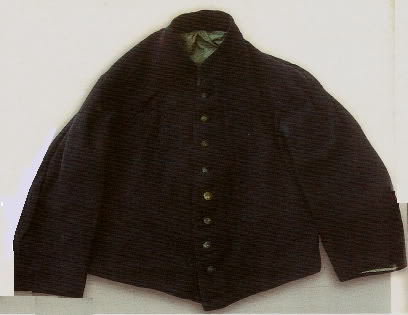
Jacket m. 1870.
la Tunique ("tunic"): model 1897, dark blue wool (100% indigo-dyed); single-breasted with one row of seven large buttons (model 1871) in brass with flaming grenade in relief; epaulette loops with small button on either shoulder; vertical madder cuff patches with three small buttons. The tunic was worn by NCOs. (See image above)
la Pantalon/Garance ("trousers/madders"): model 1867/93, madder wool; two side pockets; steel crochet with cloth strap on the back waist; zinc buttons stamped "Equipement Militaire." The interior of the cuffs are lined with a narrow band of white linen. (See image below)
les Jambières ("gaiters"): model 1913, leather (cow or horse) blackened on the outside (grain side); 17 cm high. On one side (that closer to the inside of the leg) there are three hooks and an eyelet at the bottom; on the other, two hooks with one eyelet at the top and two at the bottom. All metalware is japanned. There is a notch on the bottom rear of the gaiter in order to better conform to the boot. Note: Jambières had previously been distributed to the infantry in 1897 as a trial. This model had three hooks on one side of the jambière with one eyelet at the top and another at the bottom, while on the other side was four hooks with one eyelet on the bottom. In 1905, the initiative was formalized and the jambières were made a permanent part of the infantry uniform, although troops in the 14th and 15th Army Corps continued to use bandes molletières ("leg warps"). In 1912, a modification was made to the design so that the bottom of the jambière was notched to make it more comfortable to wear. In 1913, another modification was made so that the side of the jambière (that closer to the outside of the leg) had three hooks and one eyelet on the bottom end while the interior side had two hooks and one eyelet on top and two eyelets on the bottom end. There were also several different models of private purchase gaiters in use.
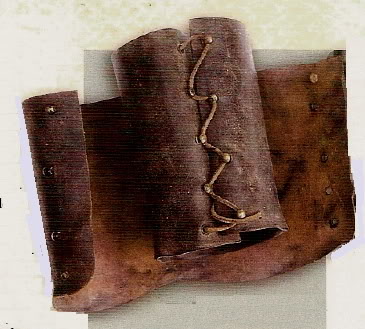
Gaiters M1905.
la Chaussure ("boots"): model 1893, blackened leather; Ankle height 16-18 cm, with 6 eyelets; hobnailed on sole (88-98 hobnails, depending on the size of the boot); leather laces. This model is distributed in its natural color and blackened by the soldier. This was the dominant model worn in 1914.
Model 1912, blackened leather; Ankle height 13-14.8 cm, with 7 eyelets (blackened brass); hobnailed on sole but less so than the model '93 (only 57-88 hobnails, depending on the size of the boot); fabric fiber laces (theoretically). The curve up the instep is increased in this model of boot. It is distributed already blackened until December 1914, after which it is given out in its natural color. (See image below)
For more information on boots and leggings, please see the 'Footwear' page.
la Cravate ("neck tie"): cotton; marine blue; 150 cm x 21 cm. It is folded in thirds and tied with a flat knot. (See image below)
la Chemise ("shirt"): model 1878, flannel cotton with collar, either pin-striped (red, black or blue), blue checkered or plain white; closed with three bone buttons; shirt-tails on both front and rear. Each man was issued two. A lighter weight cretonne cotton shirt (plain or with blue stripes) was also issued in warmer weather.
le Caleçon ("underdrawers"): cotton; either pin-striped or plain white. Each man is only issued one pair, though private purschases could be made. The prevailing notion was that the shirt, with its long tails, acted as the primary undergarment and was to be washed more frequently. In cold weather, flannel cotton underdrawers were issued.
les Bretelles ("suspenders"): Cotton thread; white with a border on each edge of a "sharp color" (e.g. pink). These were comprised of two separate braces reinforced at each end by a piece of leather where a button-hole was located. The length was adjusted by way of a metal crimp. Soldiers often replaced these with the more advantageous single-piece civilian models also of cotton.
les Chausettes ("socks"): jean-wool in summer, wool in winter; normally white but there was no regulation color. Each man received two pairs. Many peasant soldiers opted to wear "Russian socks" (i.e. cloth foot-wraps). These were about 6 inches in width and 3 feet in length.
la Plaque d'Identité ("ID plaque"): model Oct. 12, 1881, nickel. In 1914, only one plaque was worn around the neck, normally suspended from a black (fabric) shoelace or a leather lace. (See image below)
For more information on ID plaques, please see the ID Plaques and Soldier Booklets page.
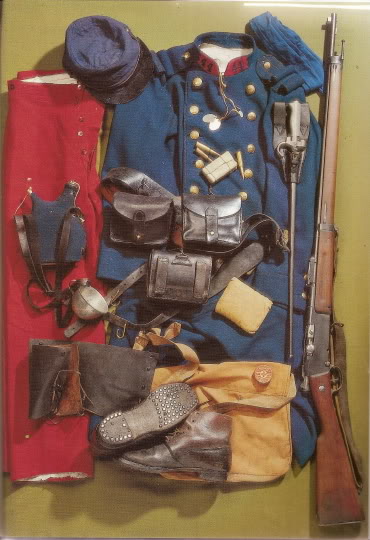 French infantryman kit, Aug. 1914. From left to right: trousers m. 1867/93, kepi m. 1884 with cover, greatcoat m. 1877, ID plaques m. 1881, neck tie, 1-liter canteen m. 1877, cup m. 1852, suspension braces m. 1892 with cartridge pouches mo. 1888, frog m. 1888, Lebel m. 1886/93, gaiters m. 1913, boots m. 1912/16 (not worn in 1914), haversack m. 1892 .
French infantryman kit, Aug. 1914. From left to right: trousers m. 1867/93, kepi m. 1884 with cover, greatcoat m. 1877, ID plaques m. 1881, neck tie, 1-liter canteen m. 1877, cup m. 1852, suspension braces m. 1892 with cartridge pouches mo. 1888, frog m. 1888, Lebel m. 1886/93, gaiters m. 1913, boots m. 1912/16 (not worn in 1914), haversack m. 1892 .
Equipment:
le Ceinturon ("belt"): model 1845, blackened leather; flat brass buckle. (See image below)
Model 1903, blackened leather; 2 pronged buckle. This model is seldom seen outside of zouave regiments in 1914.
les Cartouchières ("cartridge pouches"): model 1888, blackened leather; 2 vertical belt-loops. (See image below)
Model 1905, blackened leather; single trapezoidal loop. This model cannot be worn solely on the belt and requires the suspension braces. (See image below)
les Bretelles de Suspension ("suspension braces"): model 1892, blackened leather; with three model 1845 brass 'j-hooks'. With the introduction of the model '05 cartridge pouches, the model 1905 's-hooks' were created in order to keep them from becoming unhooked from the pouches. However, in 1914 the earlier 'j-hooks' were more dominant. (see image below)
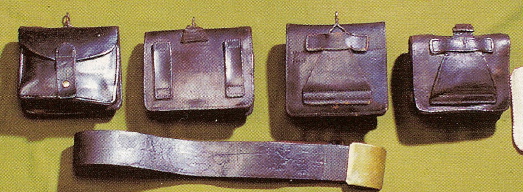 Two m. 1888 cartridge pouches (left), two m. 1905s (right), belt m. 1873.
Two m. 1888 cartridge pouches (left), two m. 1905s (right), belt m. 1873.
le Porte-Épée Baïonnette ("bayonet frog"): model 1888, blackened leather; sewn.
le Bidon ("canteen"): model 1877, tinned metal; 1-liter; canteen-cover of iron blue wool.
le Étui Musette ("haversack"): model 1892, either linen or hemp; cachou color. It is closed with two zinc buttons stamped "Equipement Militaire." Each man was issue two, one of which held his pair of rest shoes and was carried on the backpack.
la Gamelle Individuelle ("mess-kit"): model 1852, tinned metal; distributed with interior plate (aluminum) and grappling handle. These were normally left behind in the barracks for use in the mess hall.
le Quart ("cup"): model 1852, tinned metal, 25 cl. Aluminum was also used.
l'Havresac ("backpack"): model 1893, blackened canvas, fully lined with white linen cloth and interior wooden frame. There were six removable straps that attached to the pack via metal loops and buckles: two courroies de capote ("greatcoat straps" -- 75 cm x 5 cm) fixed onto the top of the pack (one on each side); two courroies de côté ("side straps" -- 52 cm x 5 cm) fixed onto the lower sides; one grande courroie de charge ("large load strap" - 1.72 m x 5 cm) that ran along the center; and one courroie de sautoir ("cross strap" -- 35 cm x 5 cm).
For details on how the backpack was arranged, see the knapsack arrangement page.
 Model 1893 backpacks.
les Outils Portatif ("portable e-tools"): model 1906 or model 1909. Each man was issued one of the following tools: spade-shovel, pick, shovel-pick, hatchet (corporals), billhook, wire-cutters, or articulated saw. Each tool was issued with a blackened leather carrying case. For specific allotment, see the e-tools distribution page.
les Ustensiles de Campement ("camping implements"): Each soldier was issued one or more of the following on the squad-level: camp mess-tin (a.k.a. "dish-for-four"), camp stew-pot (a.k.a. "bottle"), canvas bucket, distribution bag, model 1896 Klepper coffee grinder or model 1910 Montjardet camping lantern (corporals). For specific allotment, see the camping implements distribution page.
Model 1893 backpacks.
les Outils Portatif ("portable e-tools"): model 1906 or model 1909. Each man was issued one of the following tools: spade-shovel, pick, shovel-pick, hatchet (corporals), billhook, wire-cutters, or articulated saw. Each tool was issued with a blackened leather carrying case. For specific allotment, see the e-tools distribution page.
les Ustensiles de Campement ("camping implements"): Each soldier was issued one or more of the following on the squad-level: camp mess-tin (a.k.a. "dish-for-four"), camp stew-pot (a.k.a. "bottle"), canvas bucket, distribution bag, model 1896 Klepper coffee grinder or model 1910 Montjardet camping lantern (corporals). For specific allotment, see the camping implements distribution page.
Weapons:
le Fusil ("rifle"): Lebel model 1886/93. Leather sling with single-pronged buckle. Less common in 1914, was the model 1909 sling with simple sliding buckle.
l'Épée-Baïonnette ("blade-bayonet"): model 1886, steel; with quillon ("catcher"). The hilt is made of nickel.
Soldier's Kit: September-December 1914
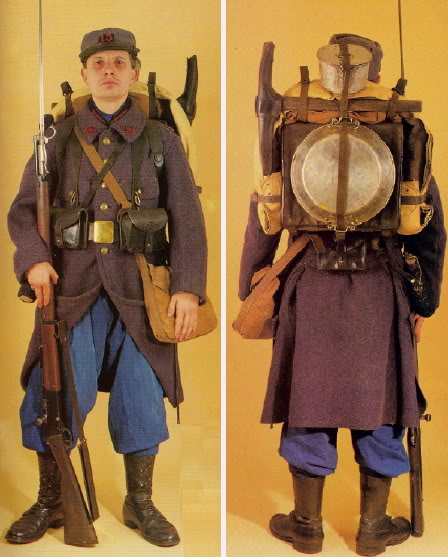 This uniform is just one example of the exigent measures taken to reduced the visibility of the uniform in the fall of 1914. The soldier wears a m. 1914 Type 3 greatcoat made from the final existing stocks of a prewar cloth that was dark bluish-gray (not common), m. 1884 kepi in the same, blue canvas trousers (overalls), m. 1913 gaiters, m. 1912 boots, m. 1873 belt, and m. 1888 or 1905 cartridge pouches.
This uniform is just one example of the exigent measures taken to reduced the visibility of the uniform in the fall of 1914. The soldier wears a m. 1914 Type 3 greatcoat made from the final existing stocks of a prewar cloth that was dark bluish-gray (not common), m. 1884 kepi in the same, blue canvas trousers (overalls), m. 1913 gaiters, m. 1912 boots, m. 1873 belt, and m. 1888 or 1905 cartridge pouches.
Uniform:
It should be noted that initially the new "light blue" (later to be called "horizon blue") cloth was referred for the fabrication of kepis and greatcoats. Jackets, trousers, legwraps and other garments were produced in the new cloth later, beginning in the winter of '14-'15.
le Képi ("kepi"): model 1884/14 - 1st Type, dark blue. In August and September of 1914, certain manufacturers begin producing a more simplified kepi before the army releases its regulation model 1914 on September 19 (see below). These hats will be identical to the model 1884s in their cut and ornamentation. However, unlike the model 1884, only one type of cloth will be used in their construction: dark blue.
Model 1884/14 - 2nd Type, various shades of light blue and bluish-gray. Even after the regulation model comes out in September, some manufacturers will continue to make kepis based on the old design but using the new cloth in every shade available. Only the piping along the seams disappears. This model will utilize both the old style of regimental number insignia in madder wool on a dark blue patch and in the new style -- dark blue numbers on a light blue patch.
Model 1914 - 1st Type, bluish-gray or light blue wool. The kepi, along with the greatcoat, were the first items to be produced in the new cloth. In order to expedite the manufacture of the new kepis the design is simplified beginning in September 1914. The entire kepi will be made composed of only one color cloth. The band and turban is formed in a single band composed of two pieces of fabric sewn together at two ends at the front and rear of the cap. The piping is also eliminated from the design.
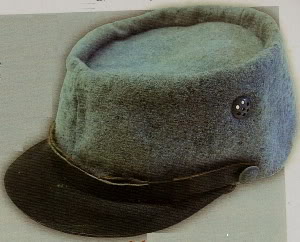
Kepi m. 1914 1st Type.
Model 1914 - 2nd Type, light blue wool. Production of the Type 2 kepi began in December 1914, after official approval from General Joffre. The new model had a lower profile. Officially, the regimental number insignia was not supposed to be sewn on the kepi. However, in the event this order was often ignored.
Felt kepi, blue gray. Beginning at the end of 1914, existing stocks of felt kepis were distributed to the men. It was made with a heavy blue gray felt in two molded pieces with the shell and visor bordered in leather, and garnished with the classic model chin strap. Aeration is provided by a single eyelet on either side of the cap. The fragility of the kepi made it ill-suited for service in the trenches. The felt is sensitive to wetness and very susceptible to losing its form, not to mention the fabric's rigidity which multiplied the risk of being crushed when not being worn. Doubtlessly for these reasons, the felt kepi was most often used in the rear-line depots and not in the zone of the armies.
Commercially-made (non-regulation) kepis. Even before the war, hat makers had marketed kepis for private purchase by soldiers, often advertising their products in catalogues. This market soared in the opening weeks of the war. Commercially-made kepis were procured directly by more style-conscious soldiers, or sent to men at the front by their families. With the adoption of the model 1914 (1st Type) kepi, some factories began producing what was referred to as the "improved" version, which closely resembled the regulation hat. Manufactured in the same light blue cloth, the improved version did differ in several ways. The cap section is made in four quarters, the liner is nicer, the aeration eyelets are more discreet than the vents on the regulation kepi and the chin strap is fancier. The use of commercially-made kepis was fairly uncommon however.
For more information on kepis, please see the 'Headgear' page.
le Bonnet de Police ("police bonnet"): model 1891, iron blue wool; canvas sweat band (45 mm wide) sewn around the interior. Often referred to simply as a calot ("cap"), it was originally intended to be worn only at barracks when in the performance of chores and punitive duties. The cap first began appearing in the front lines with the stabilization of the front in fall of 1914. It came particularly in handy as a cold-weather garment, with the sides often pulled down over the ears.
For more information on kepis, please see the 'Headgear' page.
la Capote ("greatcoat"): simplified model 1914 ("Poiret") - 1st Type, various shades of wool in gray-blue, blue-gray (or "English Blue"), light blue. The Poiret greatcoat, introduced in Sept. 1914, is much more rudimentary in design than the model 1877. The coat is single-breasted with one row of six buttons. The body of is made from one single piece of fabric, save for two triangular pieces (or gussets) added to the bottom back of the coat. All seams and hems are left unfinished and open. The sleeves no longer incorporate facings nor buttons on the cuffs, and the martingale (the half-belt on the lower back) has been removed. Theoretically, three pockets are added: two on the outside breast and the third on the interior of the (bottom) right breast (intended to hold the individual bandage). The stand-up collar is done away with in favor of a fall-down one. However, the old collar patches, consisting of the regimental numerals in iron blue sewn onto a madder patch, are retained. Sometimes only the left collar patch was sewn on. The buttons on the coat vary widely. The original brass buttons are still used but are in deficiency. Therefore, the use of ersatz buttons made of horn, wood (which were covered in cloth), bronze and brass were used, particularly the last two. These were regulated to be burnished down to be less shiny.

Greatcoat m. 1914 1st Type.
Model 1914 - 2nd Type, various shades of wool in grey-blue, blue-gray, light blue. The Poiret 2nd Type was introduced in Nov. 1914 and differed from the 1st Type by the absence of either the outside left breast pocket or both breast pockets.
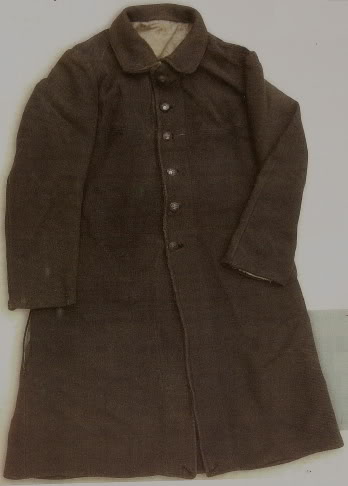

Two examples of the greatcoat m. 1914 2nd Type, in a particularly dark shade of bluish-gray (imported) and the more standard light blue.
Model 1914 - 3rd Type, various shades of wool in grey-blue, blue-gray, light blue. The Poiret 3rd Type was introduced in Dec. 1914 and saw the reintroduction of the outside breast pockets and rear vent pockets. Two interior pockets were added to either side of the chest. The martingale was also added back. This type of Poiret was probably not in too great of a presence until early 1915.
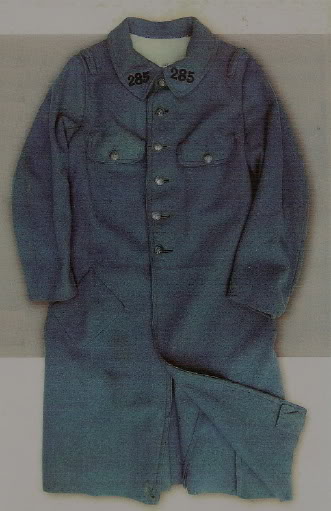
Greatcoat m. 1914 3rd Type.
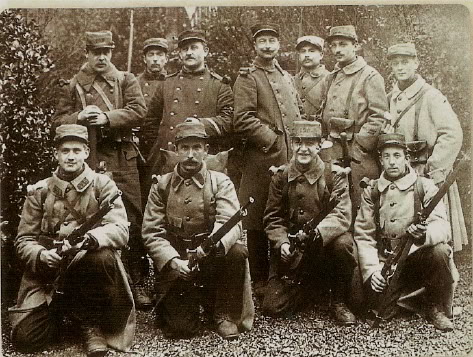
Various models of greatcoat, ca. fall/winter of 1914. Four of the men standing in the 2nd row wear the m. 1877, with the man on the far left wearing a less common version with a fall-down collar (see description above). All others are wearing the m. 1914 2nd Type.
la Veste ("jacket"): With the continued shortage of regulation jackets, beginning in the fall of 1914, jackets in velour or civilian fabrics were distributed in neutral shades. Certain regiments were issued with the model 1897 NCO's tunic. Regardless, the number of jackets and tunics was insufficient. With winter approaching, as an emergency measure the army began distributing drab civilian jackets in velour, which generally had a longer cut. Later, soldiers were also allowed to purchase and wear numerous civilian models, including hunting jackets, work jackets, and exercise jackets in various shades of gray and brown.
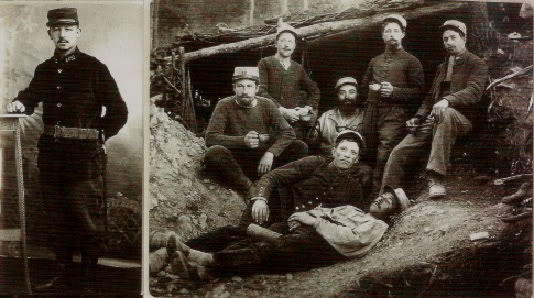
The soldier in the left photo wears a civilian velour jacket; in the photo on the right, a man reclining on the ground wears the m. 1897 NCO's tunic. The two men on the right wear the m. 1870 jackets, while the others wear various types of civilian jackets and pull-overs (ca. fall 1914).
la Vareuse ("blouse"/"jacket"): model 1914, light blue wool; single-breasted with one row of five small grenade buttons (theoretically); stand-up collar; belt loop on left side; two vents are incorporated on each side; unlined but with two interior canvas pockets on the chest. There are also two exterior front ("belt") pockets, which are closed by a buttoned flap. When this jacket was adopted in December 1914, all types of shades of cloth were utilized, as priority for the new light blue cloth was reserved for the greatcoats. Examples also exist of jackets fitted out with smooth tin buttons in blue. Later versions will also incorporate canvas liners. It won't be until April of 1915 that an order will be issued regulating that only light blue cloth be used in construction. The model 1914 jacket became an item regularly worn under the greatcoat as part of the field order when it began appearing more as distribution picked up in early 1915.
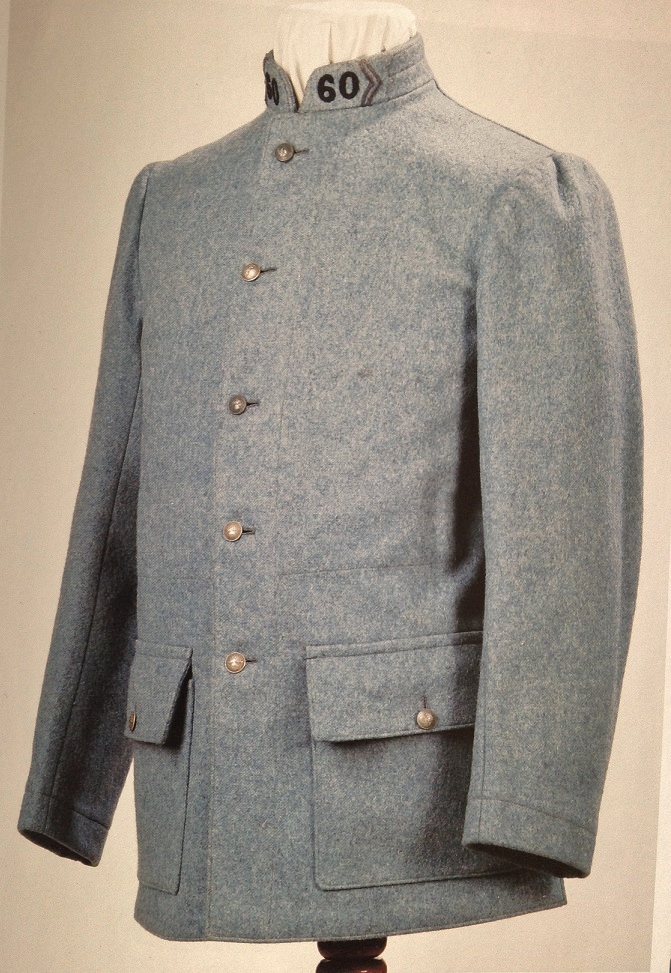
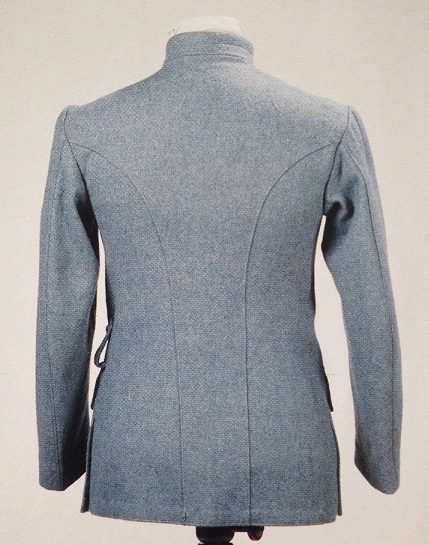
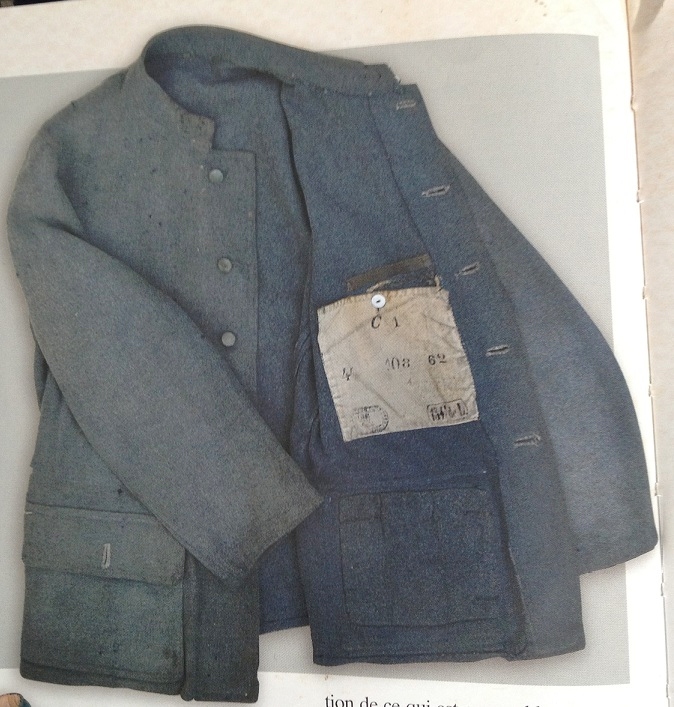
M. 1914 jacket.
la Pantalon de Toile Bleue ("blue cloth trousers"): On 12 October 1914, blue cloth trousers were adopted for use to combat the conspicuous sight of the madder red trousers. Various models and shades of blue canvas trousers were quickly thrown into production. Thousands more were purchased from commercial (civilian) workshops, which is why these trousers were also referred to as "mechanic's" trousers. The blue canvas trousers were actually overalls intended to be worn over the madder trousers. Besides covering over the bright red of the troops' trousers, they were also intended to provide additional protection from the cold. One unique design of the contracted version was the replacement of side pockets with simple vents to allow the wearer to reach the pockets of his trousers being worn underneath.
les Pantalons Divers ("diverse trousers"): In addition to the overalls, trousers in the old pattern (M1867) and made of dark blue wool were provisioned to replacement troops starting at the end of October 1914. Supplementing these stocks was the requisition of trousers in dark iron gray wool, taken mainly from local fire departments. These had scarlet piping running down the outside seams. Unlike the canvas trousers, the firemen's trousers were meant to replace the madders. Finally, at the end of the year, some units begin taking the initiative of acquiring civilian trousers made of corduroy. Eventually, these will be officially adopted for acquisition and distribution by the Army Quartermaster Corps. Corduroys in various shades of brown, dark brown, tan, dark blue, and light blue will appear. (See image above)
les Jambières ("gaiters"): the old gaiters are still maintained until the end of the year. Though the decision to replace them with woolen leg-wraps had been made in Oct. 1914, they would still be seen in used into the spring and even summer of 1915. This included both the regulation model and private purchase versions made in both leather or canvas.
les Bandes Molletières ("woolen leg-wraps"): model 1910, dark blue wool (2.60 m x 12 cm); fastening ribbon (1.50 m x 15 mm) at the top end of the wrap. The decision to replace the gaiters with leg-wraps was made on Oct. 24, 1914. Previously, leg-wraps were worn only by chasseurs alpin, zouaves, and tirailleurs, and thus, the first issues of leg-wraps were dark blue. However, in December 1914, it was decided that all leg-wraps should be manufactured in either light blue or a neutral shade. Nonetheless, dark blue leg-wraps would remain dominant until the summer of 1915. Private purchase leg-wraps could also be had, and can normally be distinguished by their great length (3-4 meters).
la Chaussure ("boots"): model 1893, blackened leather. Ankle height 16-18 cm, with 6 eyelets; hobnailed on sole and heal (88-98 hobnails, depending on the size of the boot); leather laces. This model is distributed in its natural color and blackened by the soldier. This was the dominant model worn in 1914.
Model 1912, blackened leather. Ankle height 13-14.8 cm, with 7 eyelets (blackened brass); hobnailed on sole and heal but less so than the model '93 (only 57-88 hobnails, depending on the size of the boot); fabric fiber laces. This model is distributed already blackened.
For more information on boots and leggings, please see the 'Footwear' page.
la Toile de Tente ("tent canvas"): model 1897 or model 1897/14, impermeable cotton-canvas (1.60 sq. meters); various shades of khaki or cachou. The difference between the model 1897 and 1897/14 was the addition (to the latter) of either canvas loops or small metal rings sewn onto one side of the tent canvas. This allowed it to be worn as a poncho by passing two cords through the loops/rings: one at the neck (1.10 m) and one at the waist (2.20 m). The tent canvas did not begin to be distributed until the end of Sept./Oct. 1914. Three sides had metal buttons (normally stamped "Equipement Militaire") and eyelets, while the fourth side was fitted with three pairs of eyelets. Issued with it were two model 1908 demi-supports ("tent-poles"), three stake cords, one draw cord, and two piquets("stakes"), the latter of which were often referred to as "sardines."
la Demi-Couverture de Campement ("camp half-blanket"): various shades of beige, brown and gray (115 cm x 175 cm; 3.4 lbs.); more simply called the couvre-pied ("foot-cover") in indication of how it was only intended to cover the soldier's lower half when sleeping. The earliest models (often manufactured in the 1880s-1900s) were light beige in color with multiple brown stripes running across the ends horizontally. War-time manufactured blankets were often gray-brown in color and had less stripes or none at all. The foot-covers were embroidered in yellow stitching with 'Campement' or alternately the abbreviated 'CM,' the year of issue, the factory number and the manufacturer's initials.
Officer's Kit: August-September 1914
Image and Text Sources:
- Delpérier, Louis. "L'Officier d'Infanterie Français en 1914: 1ere partie" Militaria Magazine no. 47 (Juillet 1989): 7-12.
- Delpérier, Louis. "L'Officier d'Infanterie Français en 1914: 2eme partie" Militaria Magazine no. 50 (Oct. 1989): 8-10.
- Journal Militaire. 116e anée, deuieme semestre (1905): Libraire Militaire R. Chapelot et Co.: Paris, 333-335.
- Vauvillier, François. "Le Poilu de l'Automne de 14" Militaria Magazine no. 19 (Avril 1987): 10-13.
- Vauvillier, François. "The French Infantry in 1914: Part 1" Militaria Magazine U.S. ed. no. unknown (date unknown): 43-48.
- Vauvillier, François. "The French Infantry in 1914: Part 2" Militaria Magazine U.S. ed. no. 21 (Nov. 1995): 43-48.
- Bernard, Gilles and Gérard Lachaux. "L'Uniforme du Poilu, 1914-1918." Gazette des Uniformes, Hors Serie no. 19 (1994).
- Berrafato, Laurent. dir. "Le Fantassin de la Grande Guerre, 1914/1918." Gazette des Uniformes, Hors Serie no. 3 (1994): 6-21.
- http://orkide.club.fr/index.htm





